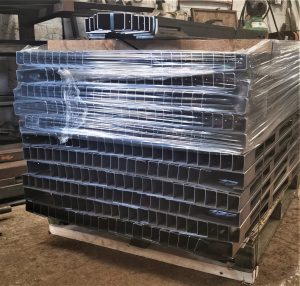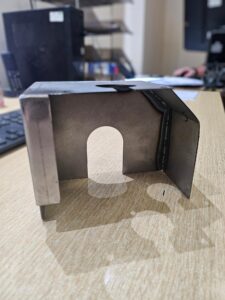Press braking, also known as pressing, bending and forming, is the process of manipulating the shape of a metal sheet through introducing bends.
We have a wide range of CNC press braking equipment, capable of pressing components up to 3.5m wide with the capability of pressing up to 20mm thick.
Due to our large capacity, we can offer a wide range of services to our customer base, from one off prototypes to high-volume production runs all with a fast turnaround.

The Efficiency of Bending Steel: A Cost-Effective Solution Over Welding
In the realm of construction and manufacturing, time and cost are pivotal factors. Welding, a fundamental process in metal fabrication, often consumes significant time and resources. However, an often-overlooked strategy for saving both time and money in welding is the strategic use of bent steel. This essay explores the efficiency of bending steel as a cost-effective solution, demonstrating how it can minimise welding time and expenses through examples and analysis.
Reduced Welding Time: Bending steel to match the desired shape or contour of a structure significantly reduces the need for welding. Consider the construction of a simple framework for a building. Traditional methods involve welding numerous joints to connect straight steel beams, consuming substantial time and labour. Conversely, utilising pre-bent steel components, such as curved beams or angled supports, minimises the number of welding joints required. This reduction in welding time translates directly into cost savings as fewer hours of skilled labour are needed to complete the project.

Example: A construction company tasked with building a curved staircase for a commercial property can save considerable time and money by utilising pre-bent steel stringers. Instead of welding together individual steps and supports, the company can simply install the pre-bent stringers, drastically reducing welding time and labour costs.
Minimised Material Waste: Bending steel allows for precise customisation of metal components, minimising material waste. Traditional fabrication methods often involve cutting straight steel sections to size, resulting in leftover scraps that may not be reusable. Conversely, bending steel enables manufacturers to create complex shapes and angles from a single piece of material, maximising efficiency and reducing scrap.
Example: In the production of metal furniture, such as chairs or tables, bending steel tubes to form intricate designs eliminates the need for welding together multiple pieces. This not only streamlines the manufacturing process but also reduces material waste, ultimately saving money on both raw materials and disposal costs.
Enhanced Structural Integrity: Beyond time and cost considerations, bending steel can also enhance the structural integrity of fabricated components. Welding introduces heat-affected zones and potential weak points in the metal, whereas bending maintains the integrity of the material. By minimising the reliance on welded joints, structures built with bent steel may exhibit greater durability and longevity.
Conclusion: In conclusion, bending steel offers a cost-effective solution for saving time and money in welding-intensive applications. By reducing welding time, minimizing material waste, and enhancing structural integrity, the strategic use of bent steel can yield significant benefits across various industries, from construction to manufacturing. As demonstrated through examples and analysis, embracing this efficient fabrication technique can result in streamlined processes, reduced expenses, and ultimately, improved project outcomes.